(精品)简单句五种基本句型
- 格式:ppt
- 大小:7.53 MB
- 文档页数:25
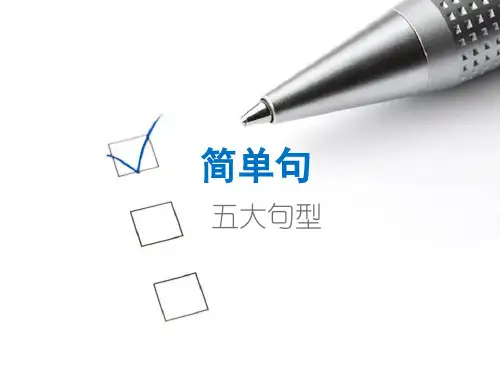
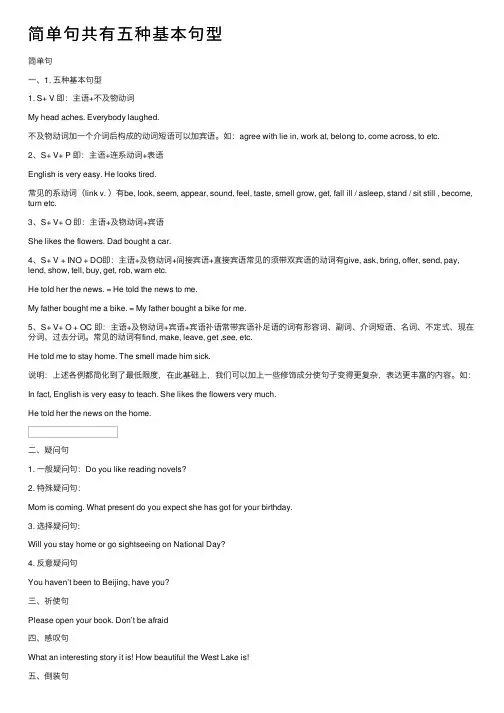
简单句共有五种基本句型简单句⼀、1. 五种基本句型1. S+ V 即:主语+不及物动词My head aches. Everybody laughed.不及物动词加⼀个介词后构成的动词短语可以加宾语。
如:agree with lie in, work at, belong to, come across, to etc.2、S+ V+ P 即:主语+连系动词+表语English is very easy. He looks tired.常见的系动词(link v. )有be, look, seem, appear, sound, feel, taste, smell grow, get, fall ill / asleep, stand / sit still , become, turn etc.3、S+ V+ O 即:主语+及物动词+宾语She likes the flowers. Dad bought a car.4、S+ V + INO + DO即:主语+及物动词+间接宾语+直接宾语常见的须带双宾语的动词有give, ask, bring, offer, send, pay, lend, show, tell, buy, get, rob, warn etc.He told her the news. = He told the news to me.My father bought me a bike. = My father bought a bike for me.5、S+ V+ O + OC 即:主语+及物动词+宾语+宾语补语常带宾语补⾜语的词有形容词、副词、介词短语、名词、不定式、现在分词、过去分词。
常见的动词有find, make, leave, get ,see, etc.He told me to stay home. The smell made him sick.说明:上述各例都简化到了最低限度,在此基础上,我们可以加上⼀些修饰成分使句⼦变得更复杂,表达更丰富的内容。
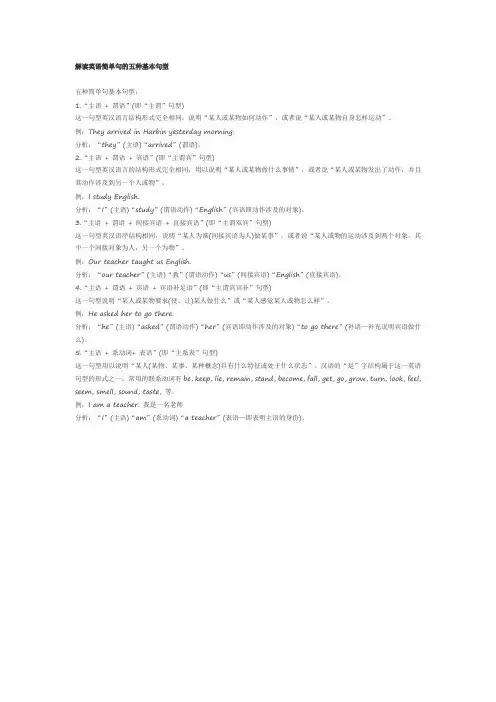
解读英语简单句的五种基本句型五种简单句基本句型:1.“主语 + 谓语”(即“主谓”句型)这一句型英汉语言结构形式完全相同,说明“某人或某物如何动作”,或者说“某人或某物自身怎样运动”。
例:They arrived in Harbin yesterday morning.分析:“they”(主语)“arrived”(谓语)。
2.“主语 + 谓语 + 宾语”(即“主谓宾”句型)这一句型英汉语言的结构形式完全相同,用以说明“某人或某物做什么事情”,或者说“某人或某物发出了动作,并且其动作涉及到另一个人或物”。
例:I study English.分析:“I”(主语)“study”(谓语动作)“English”(宾语即动作涉及的对象)。
3.“主语 + 谓语 + 间接宾语 + 直接宾语”(即“主谓双宾”句型)这一句型英汉语序结构相同,说明“某人为谁(间接宾语为人)做某事”,或者说“某人或物的运动涉及到两个对象,其中一个间接对象为人,另一个为物”。
例:Our teacher taught us English.分析:“our teacher”(主语)“教”(谓语动作)“us”(间接宾语)“English”(直接宾语)。
4.“主语 + 谓语 + 宾语 + 宾语补足语”(即“主谓宾宾补”句型)这一句型说明“某人或某物要求(使、让)某人做什么”或“某人感觉某人或物怎么样”。
例:He asked her to go there.分析:“he”(主语)“asked”(谓语动作)“her”(宾语即动作涉及的对象)“to go there”(补语—补充说明宾语做什么)。
5.“主语 + 系动词+ 表语”(即“主系表”句型)这一句型用以说明“某人(某物、某事、某种概念)具有什么特征或处于什么状态”。
汉语的“是”字结构属于这一英语句型的形式之一。
常用的联系动词有be, keep, lie, remain, stand, become, fall, get, go, grow, turn, look, feel, seem, smell, sound, taste, 等。
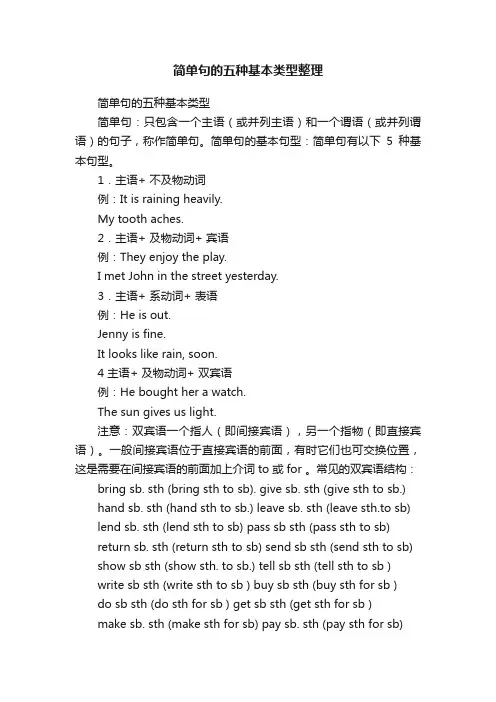
简单句的五种基本类型整理简单句的五种基本类型简单句:只包含一个主语(或并列主语)和一个谓语(或并列谓语)的句子,称作简单句。
简单句的基本句型:简单句有以下5种基本句型。
1.主语+ 不及物动词例:It is raining heavily.My tooth aches.2.主语+ 及物动词+ 宾语例:They enjoy the play.I met John in the street yesterday.3.主语+ 系动词+ 表语例:He is out.Jenny is fine.It looks like rain, soon.4 主语+ 及物动词+ 双宾语例:He bought her a watch.The sun gives us light.注意:双宾语一个指人(即间接宾语),另一个指物(即直接宾语)。
一般间接宾语位于直接宾语的前面,有时它们也可交换位置,这是需要在间接宾语的前面加上介词to 或for 。
常见的双宾语结构:bring sb. sth (bring sth to sb). give sb. sth (give sth to sb.) hand sb. sth (hand sth to sb.) leave sb. sth (leave sth.to sb) lend sb. sth (lend sth to sb) pass sb sth (pass sth to sb)return sb. sth (return sth to sb) send sb sth (send sth to sb) show sb sth (show sth. to sb.) tell sb sth (tell sth to sb )write sb sth (write sth to sb ) buy sb sth (buy sth for sb )do sb sth (do sth for sb ) get sb sth (get sth for sb )make sb. sth (make sth for sb) pay sb. sth (pay sth for sb)sing sb sth (sing sth for sb )5.主语+ 及物动词+ 宾语+ 补足语例:She found him a very clever student.I make it a rule to get up early in the morning.注意:当宾语意思表达不完整时,需要用不足与补充说明宾语的状态、性质等。
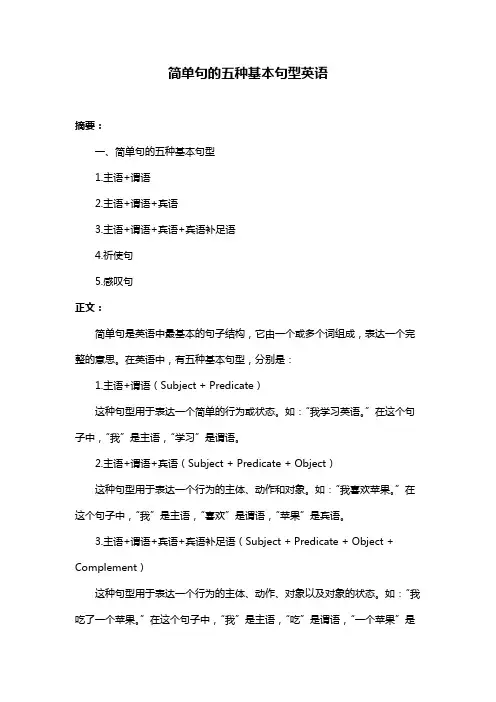
简单句的五种基本句型英语
摘要:
一、简单句的五种基本句型
1.主语+谓语
2.主语+谓语+宾语
3.主语+谓语+宾语+宾语补足语
4.祈使句
5.感叹句
正文:
简单句是英语中最基本的句子结构,它由一个或多个词组成,表达一个完整的意思。
在英语中,有五种基本句型,分别是:
1.主语+谓语(Subject + Predicate)
这种句型用于表达一个简单的行为或状态。
如:“我学习英语。
”在这个句子中,“我”是主语,“学习”是谓语。
2.主语+谓语+宾语(Subject + Predicate + Object)
这种句型用于表达一个行为的主体、动作和对象。
如:“我喜欢苹果。
”在这个句子中,“我”是主语,“喜欢”是谓语,“苹果”是宾语。
3.主语+谓语+宾语+宾语补足语(Subject + Predicate + Object + Complement)
这种句型用于表达一个行为的主体、动作、对象以及对象的状态。
如:“我吃了一个苹果。
”在这个句子中,“我”是主语,“吃”是谓语,“一个苹果”是
宾语,“了”是宾语补足语。
4.祈使句(Imperative Sentence)
祈使句用于表达命令、请求、劝告等。
如:“请打开窗户。
”在这个句子中,没有主语,只有谓语“打开”。
5.感叹句(Exclamatory Sentence)
感叹句用于表达惊喜、惊讶、赞叹等强烈情感。
如:“多么美丽的景色!”在这个句子中,“多么”是感叹词,“美丽”的“景色”是主语和宾语。
以上就是英语简单句的五种基本句型。
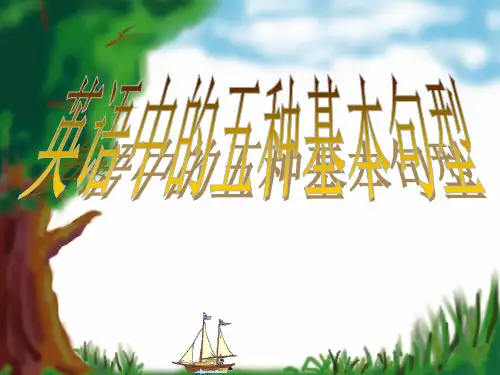
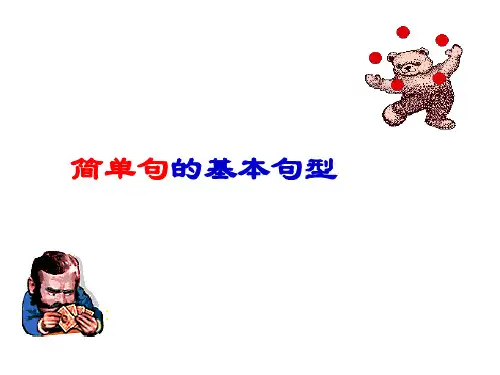

英语五种简单句基本句型英语五种简单句基本句型一.五种简单句基本句型1.“主语+谓语”(即“主谓”句型)这一句型英汉语言结构形式完全相同,说明“某人或某物如何动作”,或者说“某人或某物自身怎样运动”。
例:TheyarrivedinHarbinyesterdaymorning.分析:“they”(主语)“arrived”(谓语)。
2.“主语+谓语+宾语”(即“主谓宾”句型)这一句型英汉语言的结构形式完全相同,用以说明“某人或某物做什么事情”,或者说“某人或某物发出了动作,并且其动作涉及到另一个人或物”。
例:IstudyEnglish.分析:“I”(主语)“study”(谓语动作)“English”(宾语即动作涉及的对象)。
3.“主语+谓语+间接宾语+直接宾语”(即“主谓双宾”句型)这一句型英汉语序结构相同,说明“某人为谁(间接宾语为人)做某事”,或者说“某人或物的运动涉及到两个对象,其中一个间接对象为人,另一个为物”。
例:OurteachertaughtusEnglish.分析:“ourteacher”(主语)“教”(谓语动作)“us”(间接宾语)“English”(直接宾语)。
4.“主语+谓语+宾语+宾语补足语”(即“主谓宾宾补”句型)这一句型说明“某人或某物要求(使、让)某人做什么”或“某人感觉某人或物怎么样”。
例:Heaskedhertogothere.分析:“he”(主语)“asked”(谓语动作)“her”(宾语即动作涉及的对象)“togothere”(补语--补充说明宾语做什么)。
5.“主语+系动词+表语”(即“主系表”句型)这一句型用以说明“某人(某物、某事、某种概念)具有什么特征或处于什么状态”。
汉语的“是”字结构属于这一英语句型的形式之一。
常用的系动词有be,keep,lie,remain,stand,become,fall,get,go,grow,turn,look,feel,see m,smell,sound,taste,等。

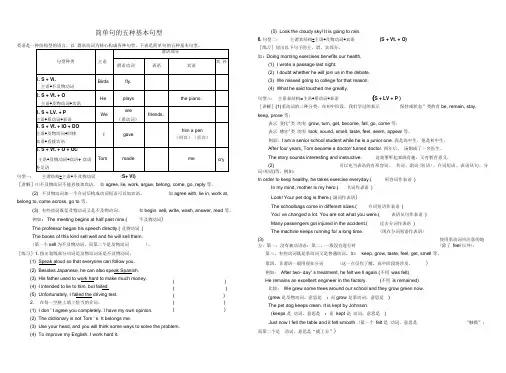
简单句的五种基本句型句型一:主谓结构=主语+不及物动词(S+ Vi)[讲解]⑴不及物动词不能直接加宾语。
如agree, lie, work, argue, belong, come, go, reply 等。
(2) 不及物动词加一个介词后构成动词短语可以加宾语。
如agree with, lie in, work at, belong to, come across, go to 等。
(3) 有些动词既是及物动词又是不及物动词。
如begin, sell, write, wash, answer, read 等。
例如:The meeting begins at half past nine.( 不及物动词)The professor began his speech directly.( 及物动词)The books of this kind sell well and he will sell them.(第一个sell为不及物动词,而第二个是及物动词)。
[练习]1.指出划线部分动词是及物动词还是不及物动词。
(1) Speak aloud so that everyone can follow you.(2) Besides Japanese, he can also speak Spanish.(3) His father used to work hard to make much money.(4) I intended to lie to him, but failed.(5) Unfortunately, I failed the driving test.2. 在每一空格上填上恰当的介词。
(1) I don ' t agree you completely. I have my own opinion.(2) The dictionary is not Tom ' s. It belongs me.(3) Use your head, and you will think some ways to solve the problem.(4) To improve my English, I work hard it.(5) Look the cloudy sky! It is going to rain.6.句型二:主谓宾结构=主语+及物动词+宾语(S + Vt. + O)[练习]划出以下句子的主、谓、宾部分。
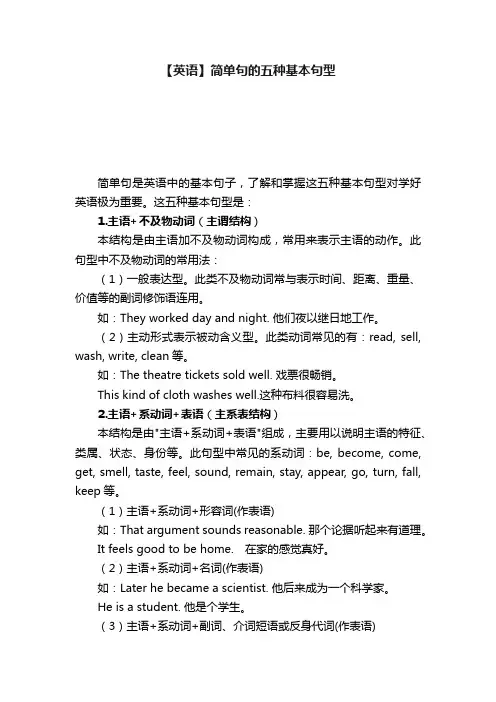
【英语】简单句的五种基本句型简单句是英语中的基本句子,了解和掌握这五种基本句型对学好英语极为重要。
这五种基本句型是:1.主语+不及物动词(主谓结构)本结构是由主语加不及物动词构成,常用来表示主语的动作。
此句型中不及物动词的常用法:(1)一般表达型。
此类不及物动词常与表示时间、距离、重量、价值等的副词修饰语连用。
如:They worked day and night. 他们夜以继日地工作。
(2)主动形式表示被动含义型。
此类动词常见的有:read, sell, wash, write, clean等。
如:The theatre tickets sold well. 戏票很畅销。
This kind of cloth washes well.这种布料很容易洗。
2.主语+系动词+表语(主系表结构)本结构是由"主语+系动词+表语"组成,主要用以说明主语的特征、类属、状态、身份等。
此句型中常见的系动词:be, become, come, get, smell, taste, feel, sound, remain, stay, appear, go, turn, fall, keep等。
(1)主语+系动词+形容词(作表语)如:That argument sounds reasonable. 那个论据听起来有道理。
It feels good to be home.在家的感觉真好。
(2)主语+系动词+名词(作表语)如:Later he became a scientist. 他后来成为一个科学家。
He is a student. 他是个学生。
(3)主语+系动词+副词、介词短语或反身代词(作表语)如:He is near. 他在附近。
This is of importance. 这很重要。
You’re not looking yourself today. 今天你看上去气色不太好。
3. 主语+及物动词+宾语(主谓宾结构)此结构是由"主语+谓语+宾语"构成。
英语简单句的基本句型任何句子都由主语(Subject)及动词(Verb) 形成。
主语有时可省略形成祈使句,但动词始终不可省略。
简单句是指只包含一个主谓结构的句子。
如 She is fond of collecting stamps. 她喜欢集邮简单句有五种基本句型:句型一:S + Vi. (主语 + 不及物动词)句型二:S + Vi. + S.C (主语 + 不及物动词又叫系动词 + 主补又叫表语)句型三:S + Vt. + O (主语 + 及物动词 + 宾语)句型四:S + Vt. + I.O + D.O (主语 + 及物动词又叫授予动词 + 间接宾语 + 直接宾语)句型五:S + Vt. + O + O.C (主语 + 及物动词又叫不完全及物动词 + 宾语 + 宾补)【单词】S(Subject)主语P(Predicate) 谓语V(Verb) 动词Vi(intransitive verb) 不及物动词Vt(transitive verb) 及物动词O(Object) 宾语D.O(direct object) 直接宾语I.O(indirect object) 间接宾语O.C(Object Complement) 宾补S.C(Subject Complement) 主补,又叫表语注意:判断动词是否及物的办法是:我__他,他被我__,如果可填入,则及物,否则不及物一、S + Vi. (主语 + 不及物动词)不及物动词本身就可以表达完整的意思,不需要宾语及补语,但有时可有副词、介词短语等状语修饰语,这些动词常见的有:appear 出现、apologize 道歉、arrive 到达、e 过来、die 死、disappear 消失、exist 存在、fall 落下、happen 发生、 rise 升起等It happend. 事情已经发生了 (主语 + 不及物动词)He fainted. 他昏倒了 (主语 + 不及物动词)The operation progressed smoothly. 手术顺利进行 (主语+ 不及物动词 + 状语)He made toward the central station. 他向中央站走去(主语 + 不及物动词 + 状语)There stands a tree. 那儿有一棵树 (there + 不及物动词+ 主语)Here es the man. 那个男人来了 (here + 不及物动词 + 主语)We stopped to watch TV. (主语 + 不及物动词 + 动词不定式)注意:动词 stop 作不及物动词时,接不定式,表示停下来做另一件事;stop 作及物动词时,接动名词,表示停下来做这件事We stopped working. 我们停止工作 (主语 + 及物动词 + 宾语)We stopped to work. 我们停下来去工作 (主语 + 不及物动词 + 动词不定式)二、S + Vi. + S.C (主语 + 不及物动词 + 主补又叫表语)这里的不及物动词是指系动词,系动词也叫连系动词,不能单独用作谓语,后边必须跟表语(亦称补语),包括形容词、名词、介词短语等,构成系表结构,来说明主语的状况、性质、特征等情况系动词分为五类:1、be 动词:am/is/areMy sister is a writer. 我的姐姐是一名作家Those pictures are very beautiful. 那些图画非常漂亮2、表示变化,bee 成为、grow 成长、turn 变成、fall 落下、get 得到、go 去、e 来、run 跑等用来表示主语变成什么样My health has grown better. 我的健康状况有所好转The soup has gone bad. 汤已经锼了3、表示状态,keep 保持、remain 仍然是、stay 保持、stand 保持等用来表示主语继续或保持一种状况或态度You should remain quiet in the hospital. 你们在医院要保持安静4、表示“似乎,看起来像”,seem 看起来、appear 相似、显得He seems to be very sad. 他看起来很伤心5、感官动词:感官动词一共5个,包括: look 看起来、sound 听起来、smell 闻起来、taste 尝起来、feel 感觉起来注意:感官动词可以接形容词作表语;也可以加 like 接名词That food really smells good. 那道食物闻起来很棒 (主语 + 不及物动词 + 形容词)The cloth feels like silk. 这块布摸起来像丝一般 (主语 + 不及物动词 + 介词短语)三、S + Vt. + O (主语 + 及物动词 + 宾语)这种句型中的动词是指及物动词,或是可以后接宾语的动词短语。
五种简单句的基本句型
一、陈述句:
陈述句又叫肯定句,是表示事实、观点、心情等客观状况、真实状态或认可什么别人的观点、表明信念、目的、条件等抽象状态的句子。
陈述句中,动词用现在时态,一般构成要素有主语、谓语、表语三部分,它的句型是:主语+谓语+表语。
如:John is a student.(约翰是一名学生)
二、祈使句:
祈使句又叫命令句,是表示请求、劝告、警告等的句子。
祈使句通常用虚拟语气,动词用现在时态,句式比较简单,一般由主语和谓语组成。
如:Please give me a hand.(请帮忙)
三、一般疑问句:
一般疑问句又叫间接疑问句,是陈述句前提出提问,期待对方回答的句子。
它通常用虚拟语气,动词用现在时态,一般由疑问代词(特殊疑问词)或疑问副词开始,主语和谓语有把握地反转组成。
如:Are you studying English?(你在学习英语吗?)
特殊疑问句又叫直接疑问句,是直接问及某一句子里的主语、谓语、宾语、定语、状语等成分的提问句。
特殊疑问句使用特殊疑问词决定要问的是哪一个句子成分,而且它的谓语可以用一般疑问的形式,一般由疑问代词或疑问副词开头,不用句子反转。
五、感叹句:
感叹句是用来表达感情上的激情,表示对某种情况的惊叹、吃惊、害怕、欢喜、惊奇等。
感叹句一般句型是主语 + 助动词 + 谓语,句中常常有表感叹的词,如:what, how, so 等,此种句型经常采用句子反转的结构。
如:How beautiful the flowers are!(这花多美呀!)。
简单句的五种基本句型简单句的五种基本句型1.定义:如果句子只有一个主语或者并列主语和一个谓语或并列谓语动词,这样的句子称为简单句。
2.基本结构共有5种,分别是:(1). 主语+谓语(不及物动词) [S + V]如:The children are playing happily.孩子们正在高兴地玩。
(2). 主语+谓语(及物动词)+宾语[S+V+O]如:The Greens enjoy living in China.-格林一家喜欢住在中国。
(3). 主语+谓语+表语[S+V+P]该句型谓语动词为连系动词。
常见的系动词有:be(是);get(变得), become(成为), turn(变得), look(看起来), feel(感到), smell(闻起来), taste(尝起来), sound(听起来), seem(似乎) 等。
如:①He became a famous doctor.他成为了一名著名的医生。
②The apple pie tastes really delicious.苹果派吃起来真是好吃。
(4). 主语+谓语+间接宾语+直接宾语[S+V+InO+DO]这种句型中的及物动词后跟双宾语,既指人的间接宾语和指物的直接宾语。
也可以把间接宾语放在直接宾语之后,但要加介词for或to。
如:①My aunt bought me a computer. = My aunt bought a computer for me. 我阿姨买给我一台电脑。
②I passed him the salt. = I passed the salt to him.我把盐递给他。
(5). 主语+谓语+宾语+宾语补足语[S+V+O+OC]如:We must keep our school clean.我们必须保持教室清洁。
3.重点难点解析(1).主系表在主系表结构中,只能作表语的形容词,常见的有:alone,asleep,afraid,alive,ill 等。
高中英语语法通霸2:简单句的五种基本结构主谓宾主系表双宾语复合宾语正确的英语句子都要符合一定的语法结构要求。
英语句子的结构可以归纳成五种基本句型。
英语句子都可以看作是这五种句型及其扩大、组合、省略或倒装构成的。
掌握这五种基本句型,是掌握各种英语句子结构的基础,也是学好其他语法知识的前提。
英语五种基本句型结构如下:主语谓语用符号表示为:①SV(主+谓)②SVO(主+谓+宾)③SVoO(主+谓+间宾+直宾)④SVOC(主+谓+宾+宾补)⑤SVP(主+系+表)主语(subject)谓语(predicate)宾语(object)定语(attribute)状语 (adverbial) 补语(complement)表语(predicative)考点1.基本句型一:SV(主+谓)这类句子的谓语动词都是不及物动词,都不带宾语,但可以带状语。
如:It is raining now. (SV)We’ve worked for 5 hours. (SV)The meeting lasted half an hour. (SV)Time flies. (SV)练习1.分析下列句子成分,并在后面括号内标明属于五种基本句型中的哪一种。
1.Dark clouds hung overhead. ( )2.Gradually a smile appeared on her face. ( )3.He is smiling all over his face. ( )4.I did well in English. ( )5.He talked loudly in the classroom yesterday.( )考点2.基本句型三:SVO(主+谓+宾)此结构是由“主语+及物动词(词组)+宾语”构成。
She likes English.We planted a lot of trees on the farm yesterday.练习2.分析下列句子成分,并在后面括号内标明属于五种基本句型中的哪一种。
小学英语知识点——五种简单句基本句型·例句句式1:主语+ 谓语(即“主谓”句型)[例句] They arrived. 他们到了。
[分析]主语+谓语=they+arrived句式2:主语+谓语+宾语(即“主谓宾”句型)[例句]I played football last Friday. 上周五我踢球来着。
[分析]主语+谓语+宾语=I+played+football句式3:主语+谓语+间接宾语+直接宾语(即“主谓双宾”句型)[例句] The teacher taught us English. 这位老师教过我们英语。
[分析]主语+谓语+间接宾语+直接宾语=the teacher+taught+us+English句式4:主语+谓语+宾语+宾语补足语(即“主谓宾宾补”句型)[例句]He asked her to go there. 他让她去那里。
[分析]主语+谓语+宾语+宾语补足语=he+asked+her+to go there句式5:主语+系动词+表语(即“主系表”句型)[例句]I am a teacher. 我是一位老师。
[分析]主语+系动词+表语=I+am(be)+a teacher(表明主语身份)小学英语知识点——五种简单句基本句型·例句句式1:主语+ 谓语(即“主谓”句型)[例句] They arrived. 他们到了。
[分析]主语+谓语=they+arrived句式2:主语+谓语+宾语(即“主谓宾”句型)[例句]I played football last Friday.上周五我踢球来着。
[分析]主语+谓语+宾语=I+played+football句式3:主语+谓语+间接宾语+直接宾语(即“主谓双宾”句型)[例句] The teacher taught us English. 这位老师教过我们英语。
[分析]主语+谓语+间接宾语+直接宾语=the teacher+taught+us+English句式4:主语+谓语+宾语+宾语补足语(即“主谓宾宾补”句型)[例句]He asked her to go there.他让她去那里。
简单句五种基本句型总结,打好英语的基础!前五个句型属于简单句的基本句型,后面三个是中考中重要的简单句句型,最后面是句子成分的名词解释。
掌握好简单句是学好语法的基础,同学们要重视哦!一. 五种简单句基本句型1.“主语 + 谓语”(即“主谓”句型)这一句型英汉语言结构形式完全相同,说明“某人或某物如何动作”,或者说“某人或某物自身怎样运动”。
例:They arrived in Harbin yesterday morning.分析:“they”(主语)“arrived”(谓语)。
2.“主语 + 谓语 + 宾语”(即“主谓宾”句型)这一句型英汉语言的结构形式完全相同,用以说明“某人或某物做什么事情”,或者说“某人或某物发出了动作,并且其动作涉及到另一个人或物”。
例:I study English.分析:“I”(主语)“study”(谓语动作)“English”(宾语即动作涉及的对象)。
3.“主语 + 谓语 + 间接宾语 + 直接宾语”(即“主谓双宾”句型)这一句型英汉语序结构相同,说明“某人为谁(间接宾语为人)做某事”,或者说“某人或物的运动涉及到两个对象,其中一个间接对象为人,另一个为物”。
例:Our teacher taught us English.分析:“our teacher”(主语)“教”(谓语动作)“us”(间接宾语)“English”(直接宾语)。
4.“主语 + 谓语 + 宾语 + 宾语补足语”(即“主谓宾宾补”句型)这一句型说明“某人或某物要求(使、让)某人做什么”或“某人感觉某人或物怎么样”。
例:He asked her to go there.分析:“he”(主语)“asked”(谓语动作)“her”(宾语即动作涉及的对象)“to go there”(补语—补充说明宾语做什么)。
5.“主语 + 系动词+ 表语”(即“主系表”句型)这一句型用以说明“某人(某物、某事、某种概念)具有什么特征或处于什么状态”。